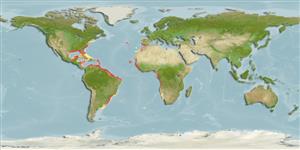Environment: milieu / climate zone / depth range / distribution range
Ekologi
laut; payau; kisaran kedalaman 10 - 180 m (Ref. 27121). Subtropical; 44°N - 40°S, 97°W - 16°E
Western Atlantic: New England, USA and Bermuda to Argentina (Ref. 47377). Eastern Atlantic: Mauritania to Namibia (Ref. 27121). Southwest Atlantic: Sergipe, Brazil (Ref. 118626).
Size / Weight / umur
Maturity: Lm ? range ? - ? cm
Max length : 100.0 cm TL jantan/; (Ref. 3694); common length : 60.0 cm TL jantan/; (Ref. 3694); Berat maksimum terpublikasi: 4.9 kg (Ref. 40637)
Duri punggung (Keseluruhan (total)) : 0; duri punggung lunak (Keseluruhan (total)) : 13 - 15; Duri dubur: 0; Sirip dubur lunak: 12 - 13.
Inhabits inshore and near-shore areas, over sand or mud bottoms. Usually found alone or in small, loose aggregates. Adults are pelagic, but near continental margins; young are commonly found on coastal and offshore banks (Ref. 7251). Feeds on fish and shrimps (Ref. 28587). Minimum depth from Ref. 26912. Its flesh is very delicate; nevertheless, in certain region like the Pacific and the Indian Ocean, it is toxic (particularly the skin and the viscera) (Ref. 5377). Poisonous, should not be eaten (Ref. 36731).
Life cycle and mating behavior
Kematangan | Reproduksi, perkembang biakan | Pemijahan | telur-telur | Fecundity | Larva
Shipp, R.L., 1990. Tetraodontidae. p. 1069-1072. In J.C. Quero, J.C. Hureau, C. Karrer, A. Post and L. Saldanha (eds.) Check-list of the fishes of the eastern tropical Atlantic (CLOFETA). JNICT, Lisbon; SEI, Paris; and UNESCO, Paris. Vol. 2. (Ref. 7464)
Status IUCN Red List (Ref. 130435: Version 2024-2)
penggunaan manusia
Perikanan: nilai komersial kecil; Ikan buruan: ya
Alat, peralatan
laporan khas
muat turun XML
Sumber internet
Estimates based on models
Preferred temperature (Ref.
123201): 16.2 - 27.3, mean 23.2 °C (based on 373 cells).
Phylogenetic diversity index (Ref.
82804): PD
50 = 0.5005 [Uniqueness, from 0.5 = low to 2.0 = high].
Bayesian length-weight: a=0.02042 (0.01599 - 0.02606), b=2.86 (2.82 - 2.90), in cm total length, based on LWR estimates for this species (Ref.
93245).
Trophic level (Ref.
69278): 4.0 ±0.69 se; based on food items.
Daya lenting (Ref.
120179): sedang, Waktu penggandaan populasi minimum 1.4 - 4.4 tahun (Preliminary K or Fecundity.).
Fishing Vulnerability (Ref.
59153): High vulnerability (60 of 100).
Nutrients (Ref.
124155): Calcium = 36.6 [14.9, 98.0] mg/100g; Iron = 1.01 [0.54, 2.12] mg/100g; Protein = 19.5 [17.4, 21.9] %; Omega3 = 0.429 [0.191, 0.878] g/100g; Selenium = 28.5 [14.1, 56.2] μg/100g; VitaminA = 9.02 [3.40, 24.30] μg/100g; Zinc = 0.688 [0.482, 0.972] mg/100g (wet weight);
